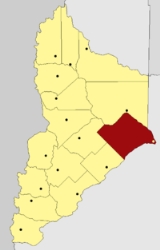
Plottier
Encyclopedia
Plottier is a city located in the Confluencia Department
, in Neuquén Province
, Argentina
.
The population is 40.000 inhabitants. It is about 15 km. from Neuquén City
that turns this city in an important place on population.
Plottier is located near the Limay River
and it is crossed by the 22 National Route
.
s, gravel
s and consolidated limos. Over the hills the ground is composed by Pebble
s denominated tehuelche Pebble. The most old grounds are composed of sandstone
s, limonite
s and clay
ey where the color is mostly red.
, the General Julio Argentino Roca asked for lands near the Neuquén river for their strategic military value. These lands were called Colonia Sayhueque.
The main economy of the region was the raising of bovine cattle and ovine cattle.
Other important activity in this area is the extraction of petroleum
.
Confluencia Department
Confluencia is a department located in the east of Neuquén Province in Argentina.Neuquén, the capital city of the province, is located in this department.The department is named Confluencia after the confluence of the rivers Negro and Limay.-Geography:...
, in Neuquén Province
Neuquén Province
Neuquén is a province of Argentina, located in the west of the country, at the northern end of Patagonia. It borders Mendoza Province to the north, Rio Negro Province to the southeast, and Chile to the west...
, Argentina
Argentina
Argentina , officially the Argentine Republic , is the second largest country in South America by land area, after Brazil. It is constituted as a federation of 23 provinces and an autonomous city, Buenos Aires...
.
The population is 40.000 inhabitants. It is about 15 km. from Neuquén City
Neuquén, Argentina
-Sister cities:Neuquén is sister city, as designated by Sister Cities International with: Knoxville, Tennessee, United States Treviso, Veneto, Italy Valdivia, Chile-External links: - Official website....
that turns this city in an important place on population.
Plottier is located near the Limay River
Limay River
The Limay River is an important river in the northwestern Argentine Patagonia . It is born at the eastern end of the Nahuel Huapi Lake and flows in a meandering path for about 380 km, collecting the waters of several tributaries, such as the Traful, the Pichileufú and the Collón Curá. It then meets...
and it is crossed by the 22 National Route
National Route 22 (Argentina)
National Route 22 is a highway located in Argentina, that connects the provinces of Buenos Aires, La Pampa, Río Negro and Neuquén in . The route starts at the connection with...
.
History
The city is named after Dr. Alberto Plottier founder of the city, a Uruguayan doctor who established an agrarian settlement at the beginning of the century.Geography
The ground in the valley is wet, composed of sandSand
Sand is a naturally occurring granular material composed of finely divided rock and mineral particles.The composition of sand is highly variable, depending on the local rock sources and conditions, but the most common constituent of sand in inland continental settings and non-tropical coastal...
s, gravel
Gravel
Gravel is composed of unconsolidated rock fragments that have a general particle size range and include size classes from granule- to boulder-sized fragments. Gravel can be sub-categorized into granule and cobble...
s and consolidated limos. Over the hills the ground is composed by Pebble
Pebble
A pebble is a clast of rock with a particle size of 4 to 64 millimetres based on the Krumbein phi scale of sedimentology. Pebbles are generally considered to be larger than granules and smaller than cobbles . A rock made predominantly of pebbles is termed a conglomerate...
s denominated tehuelche Pebble. The most old grounds are composed of sandstone
Sandstone
Sandstone is a sedimentary rock composed mainly of sand-sized minerals or rock grains.Most sandstone is composed of quartz and/or feldspar because these are the most common minerals in the Earth's crust. Like sand, sandstone may be any colour, but the most common colours are tan, brown, yellow,...
s, limonite
Limonite
Limonite is an ore consisting in a mixture of hydrated iron oxide-hydroxide of varying composition. The generic formula is frequently written as FeO·nH2O, although this is not entirely accurate as limonite often contains a varying amount of oxide compared to hydroxide.Together with hematite, it has...
s and clay
Clay
Clay is a general term including many combinations of one or more clay minerals with traces of metal oxides and organic matter. Geologic clay deposits are mostly composed of phyllosilicate minerals containing variable amounts of water trapped in the mineral structure.- Formation :Clay minerals...
ey where the color is mostly red.
Climate
The medium annual temperatures are between 57,2 °F (14°C) and 53,6 (12 °C). The amount of water from the rain is less than 300 mm a year and the strong winds of the zone are between 12.42 mph (20 km/h) and 74.56 mph (120 km/h).History
After the Conquest of the DesertConquest of the Desert
The Conquest of the Desert was a military campaign directed mainly by General Julio Argentino Roca in the 1870s, which established Argentine dominance over Patagonia, which was inhabited by indigenous peoples...
, the General Julio Argentino Roca asked for lands near the Neuquén river for their strategic military value. These lands were called Colonia Sayhueque.
The main economy of the region was the raising of bovine cattle and ovine cattle.
Economy
The main production of the zone is the agriculture. Apples and pears are the main cultives.Other important activity in this area is the extraction of petroleum
Petroleum
Petroleum or crude oil is a naturally occurring, flammable liquid consisting of a complex mixture of hydrocarbons of various molecular weights and other liquid organic compounds, that are found in geologic formations beneath the Earth's surface. Petroleum is recovered mostly through oil drilling...
.

